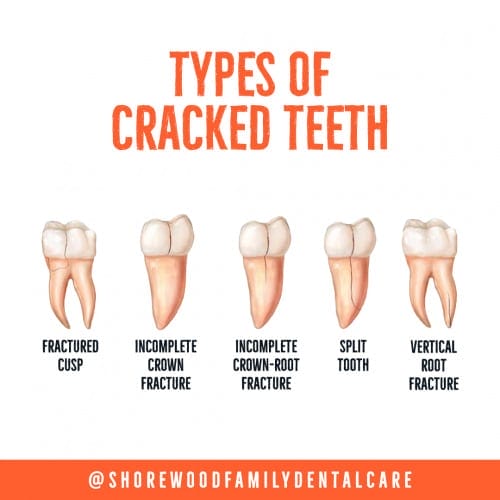
We rely on our teeth to do a lot of hard work. In addition to breaking down food before it hits our stomachs, your teeth are also often subject to damaging habits such as grinding and clenching. Then add potential injury from working out and sports to the equation. That’s why in addition to overall oral health, your dentist checks for a cracked tooth during your bi-annual visits.
Cracked teeth are often the cause of toothaches, but they can also occur without triggering any telltale pain. Whether a cracked tooth is caused by trauma or day-to-day wear and tear, the first thing your dentist does is classify what type of fracture it is to determine the appropriate treatment.
Key Categories
The American Academy of Endodontists classifies cracks into five categories:
Craze Lines
These typically appear as faint vertical lines in the tooth’s enamel that do not extend to the gums. There’s no immediate treatment required to address craze lines, but your dentist will keep an eye on them to assess if they begin to extend into the tooth dentin.
Split Tooth
As the name suggests, the crack in the tools extends from the surface to the root. This condition qualifies as a dental emergency and you should seek immediate care. In most cases, you will need to have the tooth extracted. If it is a molar tooth with multiple roots, it may be possible to only remove the damaged part of the tooth and crown the remaining tooth.
Fractured Cusp
This condition is when a portion of the chewing surface of a tooth breaks off. The break doesn’t usually reach the pulp part of the tooth which holds the nerves, blood vessels and connective tissue. In most cases, your dentist will be able to save the tooth with a filling or crown.
Vertical Root Fracture
The fracture starts at the root of a tooth and extends toward the chewing surface. Unless your dentist is able salvage a part of the tooth by removing the fractured root, it’s likely the tooth will need to be extracted.
Cracked Tooth
A crack in your tooth that extends from the chewing surface toward the root, but does not split the tooth, can often be saved. In these cases, damage to the pulp is common and you likely experience a fair amount of pain. Root canal therapy is usually required.
Preventing Cracks from Forming
You can take some steps to prevent cracked teeth:
- Have your dentist assess your teeth for signs of grinding. You may need to wear a protective mouthguard while sleeping.
- Avoid chewing hard foods such as ice and unpopped popcorn kernels.
- Don’t put hard objects in your mouth such as pens.
- Wear a protective mouthguard or mask when participating in contact sports.
The sooner a cracked tooth is identified and treated, the better the outcome. If you are concerned about a possible fracture in a tooth and need a dentist near Joliet, Shorewood Family Dental is ready to assist you.




